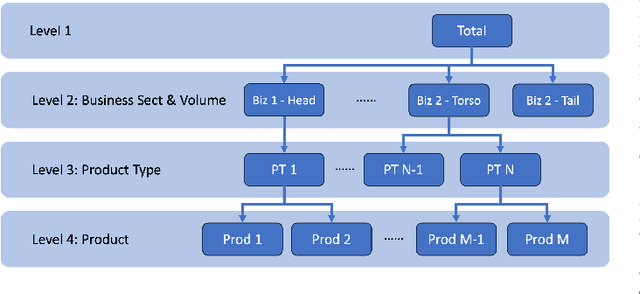Konstantin Shmakov
A Comprehensive Forecasting Framework based on Multi-Stage Hierarchical Forecasting Reconciliation and Adjustment
Dec 19, 2024



Abstract:Ads demand forecasting for Walmart's ad products plays a critical role in enabling effective resource planning, allocation, and management of ads performance. In this paper, we introduce a comprehensive demand forecasting system that tackles hierarchical time series forecasting in business settings. Though traditional hierarchical reconciliation methods ensure forecasting coherence, they often trade off accuracy for coherence especially at lower levels and fail to capture the seasonality unique to each time-series in the hierarchy. Thus, we propose a novel framework "Multi-Stage Hierarchical Forecasting Reconciliation and Adjustment (Multi-Stage HiFoReAd)" to address the challenges of preserving seasonality, ensuring coherence, and improving accuracy. Our system first utilizes diverse models, ensembled through Bayesian Optimization (BO), achieving base forecasts. The generated base forecasts are then passed into the Multi-Stage HiFoReAd framework. The initial stage refines the hierarchy using Top-Down forecasts and "harmonic alignment." The second stage aligns the higher levels' forecasts using MinTrace algorithm, following which the last two levels undergo "harmonic alignment" and "stratified scaling", to eventually achieve accurate and coherent forecasts across the whole hierarchy. Our experiments on Walmart's internal Ads-demand dataset and 3 other public datasets, each with 4 hierarchical levels, demonstrate that the average Absolute Percentage Error from the cross-validation sets improve from 3% to 40% across levels against BO-ensemble of models (LGBM, MSTL+ETS, Prophet) as well as from 1.2% to 92.9% against State-Of-The-Art models. In addition, the forecasts at all hierarchical levels are proved to be coherent. The proposed framework has been deployed and leveraged by Walmart's ads, sales and operations teams to track future demands, make informed decisions and plan resources.
Robust Consensus Clustering and its Applications for Advertising Forecasting
Dec 27, 2022Abstract:Consensus clustering aggregates partitions in order to find a better fit by reconciling clustering results from different sources/executions. In practice, there exist noise and outliers in clustering task, which, however, may significantly degrade the performance. To address this issue, we propose a novel algorithm -- robust consensus clustering that can find common ground truth among experts' opinions, which tends to be minimally affected by the bias caused by the outliers. In particular, we formalize the robust consensus clustering problem as a constraint optimization problem, and then derive an effective algorithm upon alternating direction method of multipliers (ADMM) with rigorous convergence guarantee. Our method outperforms the baselines on benchmarks. We apply the proposed method to the real-world advertising campaign segmentation and forecasting tasks using the proposed consensus clustering results based on the similarity computed via Kolmogorov-Smirnov Statistics. The accurate clustering result is helpful for building the advertiser profiles so as to perform the forecasting.
Demystifying Advertising Campaign Bid Recommendation: A Constraint target CPA Goal Optimization
Dec 26, 2022Abstract:In cost-per-click (CPC) or cost-per-impression (CPM) advertising campaigns, advertisers always run the risk of spending the budget without getting enough conversions. Moreover, the bidding on advertising inventory has few connections with propensity one that can reach to target cost-per-acquisition (tCPA) goals. To address this problem, this paper presents a bid optimization scenario to achieve the desired tCPA goals for advertisers. In particular, we build the optimization engine to make a decision by solving the rigorously formalized constrained optimization problem, which leverages the bid landscape model learned from rich historical auction data using non-parametric learning. The proposed model can naturally recommend the bid that meets the advertisers' expectations by making inference over advertisers' historical auction behaviors, which essentially deals with the data challenges commonly faced by bid landscape modeling: incomplete logs in auctions, and uncertainty due to the variation and fluctuations in advertising bidding behaviors. The bid optimization model outperforms the baseline methods on real-world campaigns, and has been applied into a wide range of scenarios for performance improvement and revenue liftup.
Do not Waste Money on Advertising Spend: Bid Recommendation via Concavity Changes
Dec 26, 2022



Abstract:In computational advertising, a challenging problem is how to recommend the bid for advertisers to achieve the best return on investment (ROI) given budget constraint. This paper presents a bid recommendation scenario that discovers the concavity changes in click prediction curves. The recommended bid is derived based on the turning point from significant increase (i.e. concave downward) to slow increase (convex upward). Parametric learning based method is applied by solving the corresponding constraint optimization problem. Empirical studies on real-world advertising scenarios clearly demonstrate the performance gains for business metrics (including revenue increase, click increase and advertiser ROI increase).
 Add to Chrome
Add to Chrome Add to Firefox
Add to Firefox Add to Edge
Add to Edge